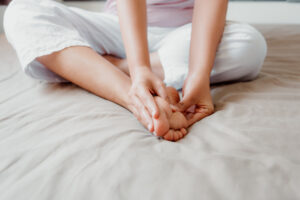Are you looking for professional foot care? Dr. Yuko Miyazaki is always glad to assist you in overcoming any impaired function or pain you are experiencing. Sometimes you can maximize home remedies to treat your foot issues. This can provide first aid until you can schedule an appointment for treatment at our Berkley, CA office. Fortunately, there are other instances where you can address your foot issues with home treatment on your own.
Schedule a visit to see Dr. Miyazaki even if you are using home treatments for your ankle or foot problem. Remember, foot pain is not something to overlook. Pain in your body is a way your body communicates that something needs to be done.
Home Remedies for Injuries
Injuries to the lower limb are very common. This is a result of several reasons. For instance, you use your ankles and feet in physical activities. Sports and running are great ways to stay fit. However, they pose a certain degree of injury risk. When you are going about your normal routine activities, you exert a tremendous amount of force on your feet. Over time, these forces can add up, resulting in injuries.
Luckily, most sports-related ankle and foot-related injuries can be treated without surgery. In other instances, you can find relief in the comfort of your home by using conservative care measures.
Ankle Pain
Depending on how regularly you use your feet and their physical structure and nature, ankle problems are common for both non-athletes and athletes. An ankle sprain is the most common cause of ankle pain, and this happens during an athletic event or when you misjudge a curb or step during your daily activities.
Providing prompt first aid when an ankle injury happens is vital. Consider RICE treatment as it is the best practice for an ankle injury.
- Rest: Avoid placing weight on the injured ankle for 24 to 48 hours. Use crutches to keep weight off if the pain is severe. Crutches offer you the opportunity to initiate natural healing and, at the same time, minimize the likelihood of sustaining further injury.
- Ice: Putting a cold pack of ice on the injured ankle can reduce pain and swelling.
- Compression: Reduce swelling by wrapping the injured ankle with a compression sleeve or elastic bandage. However, avoid wrapping it so tight.
- Elevation: Once you ice your ankle or anytime you are lying down or sitting, prop your feet up on a pillow. Elevating your injured feet above your heart’s level minimizes swelling and bruising.
Plantar Fasciitis (Heel Pain)
The common source of heel pain is plantar fasciitis. This condition is brought on by the plantar fascia, a fibrous band that runs down the bottom of your foot and becomes strained due to extreme use. This strain on the fascia causes tiny tears that the body mends when you rest.
Taking it easy and periodically icing your affected area for 15-20 minutes is the best way to start home treatment. Rest gives your body time to heal the injured tissues. Ice, on the other hand, relieves pain and controls swelling. In addition, you can try stretching exercises, arch support, and non-steroidal anti-inflammatory drugs (NSAIDs), which you can buy over the counter.
Home Treatments for Skin and Nail Issues
You can also treat skin and toenail issues at home, besides lower limb issues.
Foot Athlete’s
An athlete’s foot is a common fungal infection that begins between the toes and spreads across the whole foot. Redness and itching are the main symptoms when the feet are exposed to the air.
In the case of moderate and mild cases, over-the-counter power and antifungal sprays work very well in eradicating the nasty fungus. Ensure you follow the listed instructions carefully when using these products.
Dry Skin
When the skin on your foot starts to harden and crack, it becomes a problem. Fissures occur because dry skin rarely has normal elasticity. This can result in pain, increasing the risk of a potential infection.
If you have dry skin, here are a few steps you can take to improve this condition from the comfort of your home:
- Use a basin that can fit both feet and fill it with warm water.
- Once the basin is full, add a cup of Epsom salt. Mix the salt with water until it dissolves.
- In the mixture, add one tablespoon of baking soda (helps get rid of bad odor and relieves dry skin).
- Add essential oils or herbs if you like a pleasant aroma. Spearmint leaves, peppermint, lemon oil, and chamomile are great options.
- Place your feet in the basin, and soak them for 20 min. After a while, gently pat your feet dry and spread an oil-based moisturizing lotion.
Ingrown Toenails
You can easily get an infection from ingrown toenails. Here is a home treatment plan you can consider while you wait to see Dr. Miyazaki.
- Place your feet in warm water daily for 15 min to soften the skin around the ingrown toenails. For some added benefits, consider adding Epsom salt to the warm water.
- To prevent the toenail issue from wounding your skin, lift the ingrown edge slowly and put a small piece of clean, waxed dental floss under the nail’s corner. This forces the nail to grow as it is supposed to. Repeat this process daily until the nail has grown out and can be trimmed accordingly.
- Cut your toenail straight instead of rounding it off to avoid sharp ends from cutting into your skin.
- Keep your feet dry and clean to reduce infection risk, and wear the right shoes for comfort.
- Take aspirin, ibuprofen (Advil, Motrin) or naproxen (Aleve) to help ease pain and swelling.
Medical Professional Care and Advice
If you have an issue with your home treatments for foot issues, schedule an appointment with us. We will gladly help. Contact us today at our Berkley, CA, office to book an appointment.
